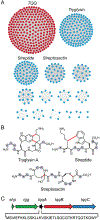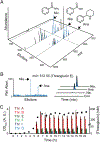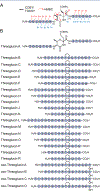Vitamin B3 Triggers Biosynthesis of Secondary Metabolite Dormancy Signals in Streptococcus suis
- PMID: 35969232
- PMCID: PMC10171913
- DOI: 10.1021/jacs.2c05790
Vitamin B3 Triggers Biosynthesis of Secondary Metabolite Dormancy Signals in Streptococcus suis
Abstract
Human-associated streptococci have not been viewed as productive sources of natural products. Against expectation, bioinformatic searches recently revealed a large collection of diverse biosynthetic gene clusters coding for ribosomally synthesized and post-translationally modified peptides (RiPPs) in streptococcal genomes. The most abundant of these, the tqq gene cluster, is specific to Streptococcus suis, a burdensome agricultural pathogen and zoonotic agent. Herein, we used high-throughput elicitor screening to identify both small molecule elicitors and products of the tqq cluster. We show that the B3 vitamin niacin effectively elicits the tqq cluster leading to the biosynthesis of a family of RiPP natural products, which we termed threoglucins and characterized structurally. The defining feature of threoglucins is an aliphatic ether bond giving rise to a substituted 1,3-oxazinane heterocycle in the peptide backbone. Isolation of 22 congeners of threoglucins facilitated structure activity relationship studies, demonstrating the requirement for the oxazinane substructure and a Trp-Tyr C-terminal dyad for biological activity, namely antibiotic persistence and allolysis at low and high doses, respectively. Potential therapeutic applications of threoglucins are discussed.
Figures




References
-
- Newman DJ; Cragg GM Natural products as sources of new drugs over the nearly four decades from 01/1981 to 09/2019. J. Nat. Prod 2020, 83, 770–803. - PubMed
Publication types
MeSH terms
Substances
Grants and funding
LinkOut - more resources
Full Text Sources

